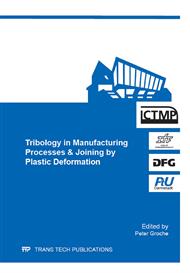[1]
A. Gåård, P.V. Krakhmalev, J. Bergström, N. Hallbäck, Galling resistance and wear mechanisms - Cold work tool materials sliding against carbon steel sheets. Tribol. Lett. 26 (2007) 67-72.
DOI: 10.1007/s11249-006-9186-5
Google Scholar
[2]
A. Gåård, P. Krakhmalev, J. Bergström, Wear mechanisms in deep drawing of carbon steel - Correlation to laboratory testing. Tribo Test 14 (2008) 1-9.
DOI: 10.1002/tt.49
Google Scholar
[3]
A. Gåård, P. Krakhmalev, J. Bergström, Wear mechanisms in galling: Cold work tool materials sliding against high-strength carbon steel sheets. Tribol. Lett. 33 (2009) 45-53.
DOI: 10.1007/s11249-008-9390-6
Google Scholar
[4]
A. Määttä, P. Vuoristo, T. Mäntylä, Friction and adhesion of stainless steel strip against tool steels in unlubricated sliding with high contact load. Tribol. Int. 34 (2001) 779-786.
DOI: 10.1016/s0301-679x(01)00074-3
Google Scholar
[5]
T. Herai, M. Ejima, K. Yoshida, K. Miyauchi, H. Ike, Frictional surface damage and its mechanism in metal sheets. Sci Pap Inst Phys Chem Res (Tokyo) 72 (1978) 1-13.
Google Scholar
[6]
P. Karlsson, A. Gåård, P. Krakhmalev, J. Bergström, Galling resistance and wear mechanisms for cold-work tool steels in lubricated sliding against high strength stainless steel sheets. Wear 286-287 (2012) 92-97.
DOI: 10.1016/j.wear.2011.04.002
Google Scholar
[7]
P. Karlsson, P. Krakhmalev, A. Gåård, J. Bergström, Influence of work material proof stress and tool steel microstructure on galling initiation and critical contact pressure. Tribol. Int. 60 (2013) 104-110.
DOI: 10.1016/j.triboint.2012.10.023
Google Scholar
[8]
E. van der Heide, D.J. Schipper, Galling initiation due to frictional heating. Wear 254 (2003) 1127-1133.
DOI: 10.1016/s0043-1648(03)00324-7
Google Scholar
[9]
E. Schedin, Galling mechanisms in sheet forming operations. Wear 179 (1994) 123-128.
DOI: 10.1016/0043-1648(94)90229-1
Google Scholar
[10]
C. Boher, D. Attaf, L. Penazzi, C. Levaillant, Wear behaviour on the radius portion of a die in deep-drawing: Identification, localisation and evolution of the surface damage. Wear 259 (2005) 1097-1108.
DOI: 10.1016/j.wear.2005.02.101
Google Scholar
[11]
B. Podgornik, S. Hogmark, Surface modification to improve friction and galling properties of forming tools. J. Mater. Process. Technol. 174 (2006) 334-341.
DOI: 10.1016/j.jmatprotec.2006.01.016
Google Scholar
[12]
E. van der Heide, A.J. Huis in 't Veld, D.J. Schipper, The effect of lubricant selection on galling in a model wear test. Wear 251 (2001) 973-979.
DOI: 10.1016/s0043-1648(01)00761-x
Google Scholar
[13]
B. Podgornik, S. Hogmark, O. Sandberg, Influence of surface roughness and coating type on the galling properties of coated forming tool steel. Surf. Coat. Technol. 184 (2004) 338-348.
DOI: 10.1016/j.surfcoat.2003.11.002
Google Scholar
[14]
B. Podgornik, S. Hogmark, O. Sandberg, Proper coating selection for improved galling performance of forming tool steel. Wear 261 (2006) 15-21.
DOI: 10.1016/j.wear.2005.09.005
Google Scholar
[15]
U. Wiklund, I.M. Hutchings, Investigation of surface treatments for galling protection of titanium alloys. Wear 250-251 (2001) 1034-1041.
DOI: 10.1016/s0043-1648(01)00730-x
Google Scholar
[16]
I. Heikkilä, L. Slycke, O. Sandberg, Influence of nitrogen alloying on galling properties of PM tool steels. Proceedings of the 6th International Tooling Conference (2002) 217-226.
Google Scholar
[17]
I. Heikkilä, M. Lundberg, L. Gunnarsson, A. Feiler, Rutland M, The contribution of the surface properties of tool steels for galling behaviour in sheet metal forming. Proceedings of the 7th International Tooling Conference 1 (2006) 351-358.
Google Scholar
[18]
U. Wiklund, B. Casas, N. Stavlid, Evaporated vanadium nitride as a friction material in dry sliding against stainless steel. Wear 261 (2006) 2-8.
DOI: 10.1016/j.wear.2005.09.003
Google Scholar
[19]
P. Karlsson, A. Gåård, P. Krakhmalev, J. Bergström, Influence of size and distribution of hard phases in tool steels on the early stage of galling. (2012).
Google Scholar
[20]
P. Karlsson, J. Eriksson, A. Gåård, P. Krakhmalev, M. Olsson, J. Bergström, Galling resistance evaluation of tool steels by two different laboratory test methods for sheet metal forming. Lubr Sci 24 (2012) 263-272.
DOI: 10.1002/ls.1180
Google Scholar
[21]
I. Heikkilä, Influence of tool steel microstructure on galling resistance against stainless steel. Tribol. Ser. 43 (2004) 641-649.
DOI: 10.1016/s0167-8922(03)80092-5
Google Scholar
[22]
G.A. Fontalvo, R. Humer, C. Mitterer, K. Sammt, I. Schemmel, Microstructural aspects determining the adhesive wear of tool steels. Wear 260 (2006) 1028-1034.
DOI: 10.1016/j.wear.2005.07.001
Google Scholar
[23]
S. Hatami, A. Nafari, L. Nyborg, U. Jelvestam, Galling related surface properties of powder metallurgical tool steels alloyed with and without nitrogen. Wear 269 (2010) 229-240.
DOI: 10.1016/j.wear.2010.03.025
Google Scholar
[24]
H. Merchant, K.J. Bhansali, Metal Transfer and Galling in Metallic Systems: Proceedings of a Symposium, Tms, (1987).
Google Scholar
[25]
A. Gåård, P. Krakhmalev, J. Bergström, Influence of tool steel microstructure on origin of galling initiation and wear mechanisms under dry sliding against a carbon steel sheet. Wear 267 (2009) 387-393.
DOI: 10.1016/j.wear.2008.11.013
Google Scholar


